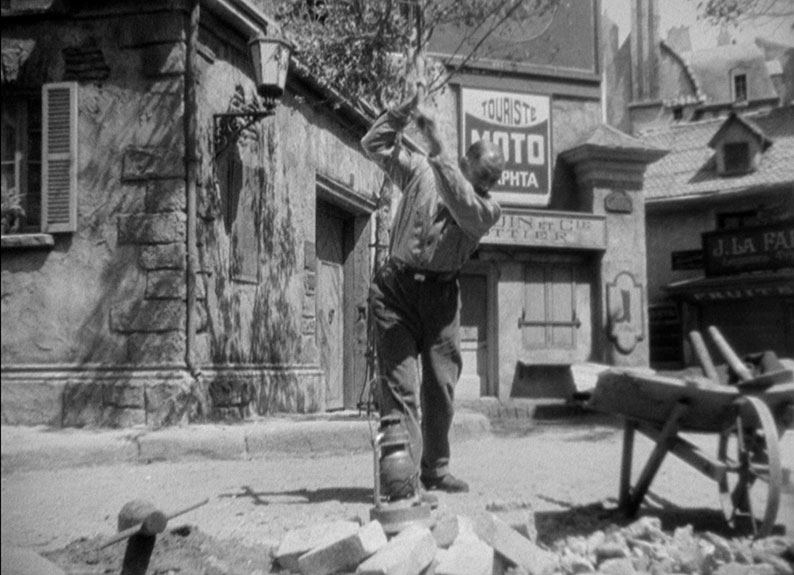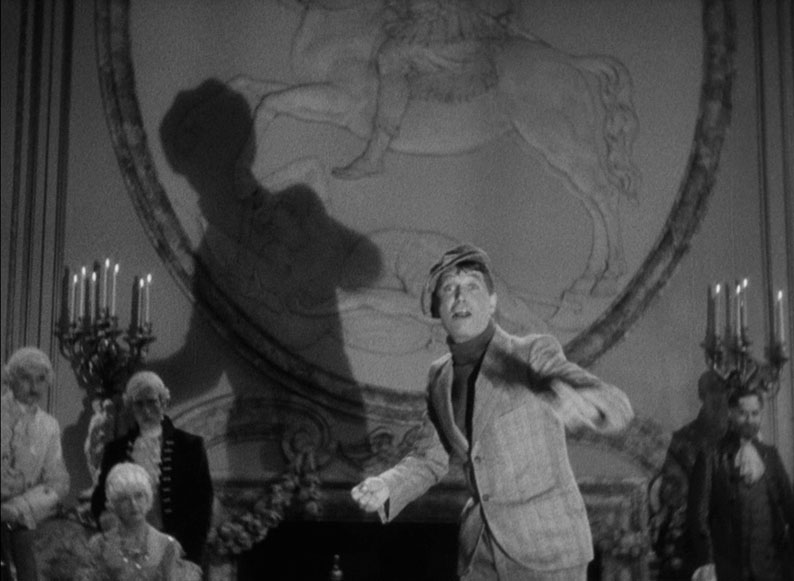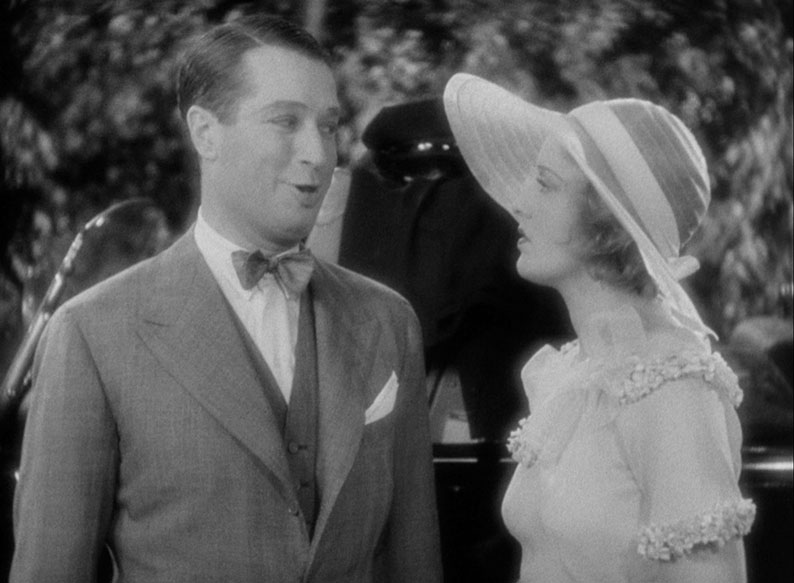|
Paris. Maurice Courtelin (Maurice Chevalier) is a tailor. Among his clients is Vicomte Gilbert de Varèze (Charles Ruggles), for whom Maurice has done work on credit. As the Vicomte has never paid, Maurice travels to the castle of the Vicomte’s uncle the Duc d’Artelines (C. Aubrey Smith) to ask for the money he is owed. While there, he meets Princess Jeanette (Jeanette MacDonald) and immediately falls for her. But will she give the time of day to a mere tailor?
The cinema was never silent. Although the 35mm nitrate print risking life and limb at your local fleapit from the mid 1890s to the late 1920s did not come supplied with a soundtrack, there would be a musical accompaniment, whether a single person on a piano or in larger plusher venues a full orchestra. Filmmakers who wished you to watch their work in cathedral silence – such as Carl Theodor Dreyer with The Passion of Joan of Arc – were rare, and even more seldomly had their wish. But when the cinema learned to talk it also learned to sing. The first (part-) talkie that many people saw was even called The Jazz Singer and featured several synch-sound musical numbers along with the two scenes of improvised dialogue that captured everyone’s attention. You ain’t heard nothing yet. And you hadn’t – within a couple of years, when all-talkies were available, the musical was a genre that packed them in, despite the distinctly lo-fi limitations of early sound technology. Many of the early musicals were screen versions of stage successes. For example, 1929’s The Desert Song added two-strip Technicolor to the mix, and a large dose of Pre-Code naughtiness that did not find favour a decade or so later with the Production Code Administration (PCA), more of which in a moment. However, in many directors’ hands, the screen musical took flight as a form that did things that you couldn’t on the stage. It wasn’t theatrical but it was cinematic. And a prime example of this is Love Me Tonight, directed by Rouben Mamoulian in 1932.

Take the opening sequence. We know we’re in Paris from the opening shots: the Eiffel Tower, the banks of the Seine and a bridge across it. As the city wakes, a man belabours the pavement with a pickaxe, someone sleeps the night off in an alleyway, a woman comes out of her shop to sweep with a broom. The sounds interact with each other, building up a percussive rhythm as each new element arrives. The camera is still, but it will move later, belying the impression (not always accurate) that sound meant that the fluidly mobile camera of silent days was now locked in place by the restrictions of the new technology. But the editing adds to the rhythm. Also in this sequence we see the first two uses of a zoom lens in a Hollywood film. And then Maurice breaks into the first song, “That’s the Song of Paree”. And it’s Rodgers and Hart’s music and lyrics you’re hearing.
Ernst Lubitsch was originally intended to make Love Me Tonight, which was written by Samuel Hoffenstein, George Marion Jr and Waldemar Young from a French play, The Tailor at the Castle (Le tailleur au château) by Paul Armont and Léopold Marchand, with those Rodgers and Hart songs added. George Cukor would also have directed it at some point. However, Rouben Mamoulian stepped in and certainly channeled a lot of Lubitsch’s famous touch, the lightness of love and an insouciant sexiness that’s on everyone’s mind but kept just enough off screen to avoid attracting the censor’s notice, though that wouldn’t always be the case.
This was Mamoulian’s fourth feature film. He had been born in 1897 in Tiflis, now Tbilisi, then in the Russian Empire but now in Georgia. He began his career as a stage director, arriving in London at the end of 1920 and accepting an offer to become the co-director of the American Opera Company in Rochester, New York, three years later. He worked on Broadway from 1927 and his theatre career ran alongside his film one, which began in 1929 with the early talkie Applause. From that film onwards, he made use of the technical possibilities of the cinema, moving the camera both indoors and outside, and the film, a backstage musical, certainly capitalised on the possibilities of sound. Between that film and Love Me Tonight, Mamoulian skipped across genres, with the crime film City Streets (1931) and the classic adaptation of Robert Louis Stevenson’s Dr Jekyll and Mr Hyde (also 1931). That film won Fredric March an Oscar for the title roles but pushed at the limits of Pre-Code horror and sexual content and attracted heavy censorship in many places, and that was before the Production Code was enforced in 1934.
Love Me Tonight is in a much lighter vein, powered by the charm of the cast, the songs and a whole panoply of cinematic technique. So we get slow motion, fast motion, a split-screen sequence and even Soviet-style montage including superimpositions. But the play’s the thing, the romantic roundelay’s the thing, and disguises are uncovered, but it all comes out in the end. It’s a triumphant film, and – using the distinction above – one of the great cinema musical comedies, as opposed to transplanted stage ones. The music and songs which are after all the film’s raison d’être are very well integrated, with the dialogue often moving into rhyme just before the singing starts.

However, the air of naughtiness didn’t find favour with Joe Breen and his fellow bluenoses at the PCA. During the Depression, the cinema was an escape for much of the population and while moralists might and did tut at increasingly gruesome horror, at gangster films seen to glorify violent criminals and the likes of Mae West and Jean Harlow sinning in style, audiences flocked to them. However, come 1934, there was a downturn in box-office receipts and threats of boycotts by the Catholic Legion of Decency, which banned their congregation from seeing films they condemned, on pain of sin. The Production Code – which had been originally drafted by Will Hays (hence the name “Hays Code”) in 1930 and largely ignored by the studios, though they still had local censor boards to deal with – was enforced. The PCA would oversee the output of the Hollywood studios for the next three decades, before being a ratings system was introduced in 1967.
With either no or very limited television, the studios relied on reissuing their films, but as of 1 July 1934 everything had to be approved by the PCA. In a way, the films which the PCA thought beyond the pale in any form came off best, as they disappeared into the vaults until being rediscovered in later years. (However, one of those, Convention City from 1933, is now a lost film.) Other films were edited before they could be shown again, and that often meant cutting the negative, not any later element. Even Oscar-winners like All Quiet on the Western Front had to be cut. Sadly, some of those films now only survive in their edited form, and Love Me Tonight is one of those. The issue with the PCA was the film’s sexual suggestiveness, and dialogue references to the “virgin spring” bit the dust. Even worse, Myrna Loy’s verse of the multiple-singer number “Mimi” halfway through the film – the only time she ever sang on screen – was excised due to the too-revealing négligée she was wearing. This material is now lost, and Love Me Tonight is about eight minutes shorter than it was originally.
Love Me Tonight didn’t trouble the Oscars, nor any other awards body, but it was inducted into the National Film Registy in 1990. Some of its songs, notably “Isn’t It Romantic?”, found further life in other films, including the one in 1948 it gave its title to, the subject of the shortest review on record, by Leonard Maltin. (“No.”) Mamoulian’s next film was Song of Songs, with Marlene Dietrich, also released on Blu-ray by Indicator, and he went on to make such classics as Queen Christina (1933, so also Pre-Code) and kept up his pioneering reputation by directing the first feature film in three-strip Technicolor, Becky Sharp (1935), which is a riot of colour in a good copy, those colours even including the old black, white and grey.
Love Me Tonight is released on Blu-ray by Powerhouse and is spine number 374 in the Indicator series, encoded for Region B only. The film has a PG certificate.
The film was made in 35mm black and white, which was shot on nitrate stock and shown that way at the time. 1932 was the year that Academy Ratio was standardised in Hollywood and the Blu-ray transfer is in that ratio, 1.37:1. This transfer is based on the 2019 restoration from Universal (who own almost all of Paramount’s library of sound features from the 1930s) from a 4K scan of a 35mm dupe negative. Inevitably the results are a little soft – which may of course reflect the look of Victor Milner’s cinematography – but in any case we don’t have the original negative available. With that in mind, it’s fine, given the film’s age and circumstances: contrast is good and it’s mostly greyscale than actual black and white, Grain is certainly present, as it should be.

The sound is the original mono, rendered as LPCM 1.0. With any film of this vintage, you do have to make allowances for the sound-recording and -mixing technology of the time, but dialogue is clear and the music and sound effects (both vital) are well balanced. English hard-of-hearing subtitles are available, and I spotted no errors in them.
Commentary by Glenn Kenny and Farran Smith Nehme
Glenn Kenny begins by quoting a director who did not make the film in question, Ernst Lubitsch: “I’ve seen Paris, France, and I’ve seen Paris, Paramount, and I like Paris, Paramount, better.” He’s joined by Farran Smith Nehme, who is a specialist in Hollywood of this period, and clearly in her element. There’s plenty of appreciation of the film’s innovative techniques, plus background on the film’s making and the careers of those involved. They also talk about the critical response to the film and Mamoulian’s work in general, from champions such as the late Tom Milne, to detractors like the also late Andrew Sarris who dismissed him as little more than a technical innovator who later ran out of ideas and whose films, he said, date badly. Needless to say, Kenny and Smith Nehme do not agree. An informative talk with a good rapport between the two of them.
Isn’t It Romantic? (27:05)
Geoff Andrew points out that he programmed a retrospective of the director’s films at the BFI Southbank. Love Me Tonight was part of that and a full house broke into applause at the end. He then takes just under half an hour explaining why, and his enthusiasm is manifest. He begins by mentioning that Mamoulian had previously directed the Broadway production of DuBose Heyward’s play Porgy (the basis of George Gershwin’s later opera Porgy and Bess) and had begun with an almost musique concrète use of street sounds without dialogue, and he does much the same with the opening of this film. Andrew does see some substance beneath the surface lightness of the film, not least an egalitarian impulse: this film may depend on class differences, from aristocrats to tailors, but during the film everyone gets to sing, even soldiers and the chef. Andrew also makes an interesting comparison, with Douglas Sirk and through him Rainer Werner Fassbinder, as this is a romance that crosses social lines, as does the former’s All That Heaven Allows, which the latter more or less remade as Fear Eats the Soul.
Hollywood on Parade excerpts:
Maurice Chevalier (2:06)
Jeanette MacDonald (2:19)
Hollywood on Parade was a series of short subjects produced by Paramount, partly to advertise the studio’s features and showcase performers from them. So here we have Chevalier and MacDonald performing a number each from Love Me Tonight.
Trailer (1:43)
Given that it begins with “The favorite of millions!” and describes the film as “the greatest piece of entertainment the screen has ever known”, you can’t accuse this trailer of selling what it advertises short. Maurice Chevalier was clearly a selling point as you get his image and name on screen in the middle of all that, while Jeanette MacDonald has to wait until about halfway through after her co-star gets his first name cited a second time. And on top of all that, it’s a “triumph of artistry created by the directorial genius of Rouben Mamoulian”, which goes to show that in 1932 some directors’ names meant something to the filmgoing public.

Image Gallery
Fifty-four images, navigable via the forward and back buttons on your remote. So we have stills, lobby cards and poster designs, including ones for Ámame esta noche, Lieb’ mich heute Nacht and Din för i kväll, as speakers of Spanish, German and Swedish would have known the film as.
Booklet
Indicator’s booklet, in this limited edition of 3000, runs to forty pages. It begins with “Everything is Rhythm” by Philip Concannon. He begins by placing Mamoulian as someone in the early-talkie era looking to “unshackle” the camera and making a film more than simply a record of a musical number. His technical innovations in his films of this period often had him facing reluctance from his crew to carry out his more elaborate ideas. Concannon also places the film in the context of its stars’ careers and he also goes into more detail than I have about the film’s later censorship at the behest of the PCA.
After that we go back to 1932 and “Mamoulian Ready for a Holiday”, an interview with Mollie Merrick with the Hartford Courant of 10 July. As he was interviewed, Love Me Tonight was still in editing. Mamoulian was already thought of as a wunderkind, still in his early thirties with an established reputation on stage as well as on screen. He talks not just about Love Me Tonight, and his casting of Chevalier, but also of his previous film Dr Jekyll and Mr Hyde, which Merrick admits to underestimating.
In September the same year, in the Pittsburgh Press, columnist Florence Fisher Parry talks about Love Me Tonight, which she hopes her readers have seen by this point. She goes on to talk about how she got to meet Mamoulian, but her account ends there. However, we do hear from the man himself in a short piece from an interview with Charles Higham and Joel Greenberg in their 1969 book The Celluloid Muse: Hollywood Directors Speak, in which he talks about his use of sound, directing the opening sequence with the aid of a metronome. And he also talks about sound with David Robinson in a 1961 issue of Sight & Sound.
Finally, we are in 1967 and Andrew Sarris interviews Mamoulian for his book Interviews with Film Directors. There is nothing here about Love Me Tonight but he talks about City Streets and especially the final closeup of Garbo in Queen Christina. Asked about the future of cinema, Mamoulian doesn’t seem very enamoured with advances in permissiveness in the cinema, or as he puts it, filmmakers “‘discovering’ sex, violence, cruelty”, given that he helped push the envelope for these subjects in the Pre-Code era. A previous extract from this interview appeared in the booklet for Indicator’s earlier release of Mamoulian’s next film, 1933’s Song of Songs.
Over ninety years old now, and sadly no longer extant in its original form, Love Me Tonight remains one of the great cinema musicals, and is well presented on this Blu-ray. Reader, I loved it.
|